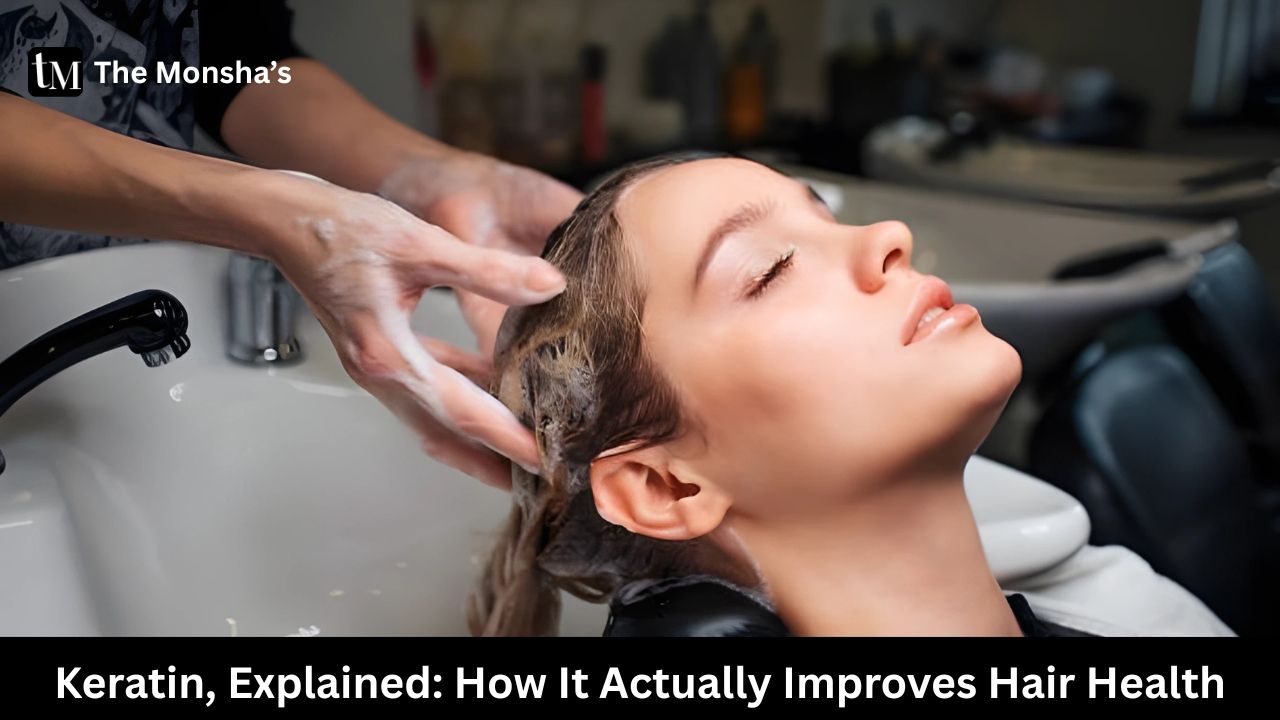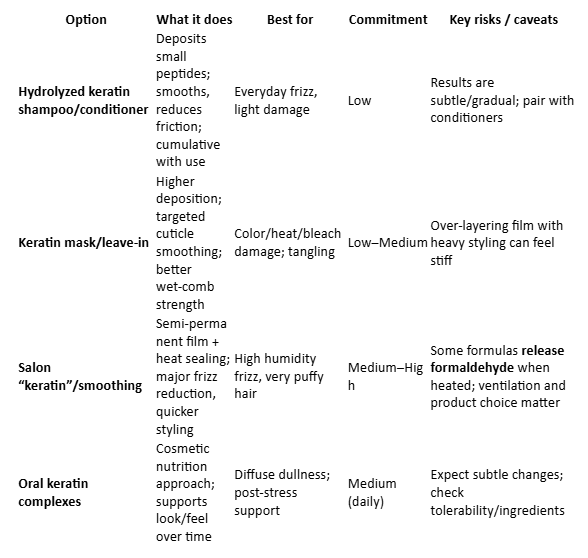
Keratin is the protein architecture of your hair. When damage shreds that architecture (heat, bleach, UV, friction), hydrolyzed keratin and well-formulated “keratin” products can fill micro-gaps, smooth the cuticle, and improve tensile strength, which means less breakage and less frizz — when used correctly. Some in-salon “keratin” services deliver a glassy, frizz-free finish by heat-bonding a film; some also release formaldehyde when heated — effective results, real safety considerations. Choose your lane wisely.
Hair = a keratin-based fiber with a protective cuticle shell and a cortex core that supplies strength. The cortex is made of keratin intermediate filaments (coiled-coil proteins) cross-linked by disulfide and hydrogen bonds — break those, and hair becomes weak, porous, frizzy.
What “keratin” means in products:

Heads-up: “Formaldehyde-free” on the label can still mean formaldehyde-releasing chemistry when heated. Always check brand tech sheets and salon ventilation.
Wash day: gentle cleanser → keratin-containing conditioner or mask (mid-lengths/ends) → rinse cool → leave-in with light film-former → heat-protectant if styling.Between washes: a peptide/keratin mist for detangling; avoid stacking heavy protein + heavy hold + daily heat (crunch city).If you do a salon service: follow the brand’s after-care (often sulfate-free cleansers, no harsh chelators for a while) to keep the film intact.
Regulators and derms flag formaldehyde-releasing hair smoothing products when heated. Reports note eye/throat irritation in salons, and hazard alerts documented airborne levels exceeding workplace limits with certain solutions labeled “formaldehyde-free.” Translation: ask questions, choose vetted products, and respect ventilation.
Derm opinions are nuanced: acute irritation is the primary concern; long-term cancer risk evidence in salon contexts remains debated and data-limited — which is not the same as “safe by default.” Err on the side of caution, especially for frequent exposures.
The internet loves the term. Evidence says what many call “protein overload” often looks like too much film + not enough emollients/humectants (aka product imbalance), though some users do feel stiffness with repeated protein layering. Practical fix: rotate conditioning agents, don’t stack five protein products in one routine, and reset with a rich, silicone-friendly or fatty-alcohol-rich conditioner as needed.
No. It can reduce breakage, so hair retains length better. Growth rate = scalp biology.
Yes, but sequence matters; many stylists color before smoothing or wait per brand guidance so films don’t block dye uptake. Ask your stylist for the product-specific window.
Not forever; after certain smoothing services, gentler cleansers help the finish last. For everyday care, pick surfactants your scalp tolerates and balance with conditioners.

Evidence note: lab work shows hydrolyzed keratin improving wet tensile strength on damaged hair tresses; that’s why combing after conditioning feels less… dramatic.
Week 1: Swap in a hydrolyzed-keratin conditioner; finish with a fatty-alcohol-rich mask once.Week 2: Add a light keratin/peptide leave-in; style with low heat.Week 3: Clarify gently once if you use heavy stylers; re-mask with keratin + emollients.Week 4: Decide if you need more. If frizz is still a menace, consult a pro about a formaldehyde-free smoothing option with proper ventilation — or keep building your at-home routine.
Keratin — the ingredient and the services that borrow its name — can meaningfully improve hair feel, strength, and frizz control when matched to your damage level and lifestyle. Pick hydrolyzed keratin for steady, safer wins; consider salon smoothing only with informed consent, ventilation, and realistic expectations. Your hair doesn’t need heroics every wash — it needs consistency, slip, heat protection, and trims. Shine, but safely. ✨